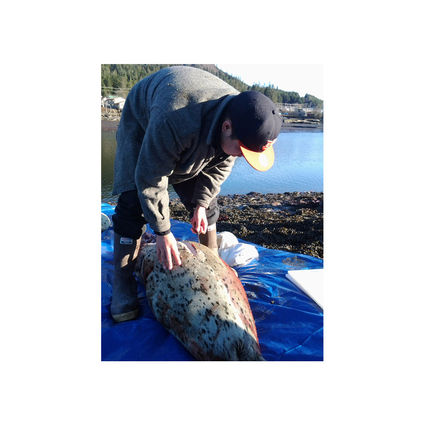Seal hunt yields unusual harvest for Wrangell

Brian O'Connor/ Wrangell Sentinel
Casey Crayne of Kake begins the butchering process on an esitimated 200-pound seal Friday afternoon on Shakes Island. Traditional oil came from hooligan in years past.
The seals' death circulated via text message, phone, and word of mouth the minute they touched the shore of Shakes Island Friday.
Alaskan Native Wrangellites had hunted, killed, butchered - and would eventually smoke and eat - harbor seals, long a traditional part of the native diet and permitted under strict guidelines by the Marine Mammal Protection and Endangered Species acts. Parts of the law allow hunting for subsistence and the manufacture of Native handicrafts, according to the Harbor Seal Commission, a group that advocates for seal hunting as part of Native culture in Alaska. The handicrafts can be sold freely, however, government agencies can impose limits or bans on hunting for some species. Hunting is restricted to Natives living in Alaska, the Pacific Northwest, and those living on the shores of the Arctic Ocean. Food sold must be consumed only in Alaska and can't be exported. Unprocessed hides can't be given to anyone who isn't Native, according to the Commission's website.
The hunters said they shot four seals, but only managed to retrieve three from their grounds on High Island, including one estimated at almost 200 pounds. The fourth seal was sucked away by the tide before hunters could retrieve it, they said.
People gathered around a tarp in the slanting evening sun to watch as the seals were cut open one at a time, and the organs were removed in a process somewhere halfway between dressing a deer and gutting a fish.
This year's relatively successful seal hunt comes on the heels of a fall hunt last year that didn't net a seal, said SouthEast Alaska Regional Health Consortium Traditional Foods program director Ken Hoyt. SEARHC organized this year's seal camp, which also included hooligan fishing. The hunt isn't bound by a strict season, though Native hunters traditionally take a break in summer to allow seal populations to replenish, Hoyt said.
"It's a culturally sound alternative to beef and chicken, things you find in the grocery store," he said. "This is healthier. People don't eat seal that much in Wrangell, but that should change, because it's delicious."
"This is plenty of seal," he added.
Every part of the seals themselves will be used. The intestines will be braided and smoked, hides will be tanned and used to make handicrafts. The blubber would eventually be boiled, then fried. Other parts would be reduced to make seal oil, a traditional food and cure-all, according to Candy Pete, who grew up in Stebbins on the Bering Sea.
"You use it for food, you use it for health," she said. "If somebody used to have a really bad earache, you put warm seal oil on their ear and it takes the bubbles out of the ear."
The oil itself formed the basis of a pre-European-contact – normally shortened to 'pre-contact' – economy between coastal communities like Wrangell, and those in interior Canada, Hoyt said.
"It's fallen out of heavy practice, like many of our foods, but it's time for it to come back," he said. "It's time for Wrangell as a whole to be proud of its Tlingit heritage, including foods like seal and grease."
By Saturday morning, the seals had been relocated to more even ground between the carving facility and the Stikine Native Organizations building. Butchers were hard at work separating blubber from the skins using uluit. The method for butchering the seals can vary from tribe to tribe, village to village, or even from family to family, Pete said.
"I grew up ... seal," she said. "I mean, all our foods we got growing up were from the ocean. Seal, walrus, beluga. We butchered them all the time, we hung 'em out to dry. We processed the seal, but
everyone does theirs differently."
Several Natives like Sandy Churchill said they were particularly excited about the liver.
"I've heard it's the best part," she said. "I'm excited to try a piece."
Churchill is among the more experienced Wrangellites with seal hunting, though until now, most of her experience has to do with reporting totals of Southeast seals taken to the State of Alaska. Unlike many other harvesters, who
sometimes eat only the heart and liver and use the rest for trap bait or other practical purposes, traditional hunting
methods use the whole animal, Churchill said. The practice of seal hunting is rare in Wrangell, Churchill added.
"We didn't grow up with them," she said. "Our generation didn't. I don't even think the elders we have left now are seal eaters."
The seal camp aimed at exposing as many locals as possible to seal hunting in the hopes that seal will become a more prevalent part of the local traditional foods diet, Hoyt said. Traditional oil production in Wrangell has centered on the hooligan, and seal is one option for supplementing it.
Of course, whether or not that's possible could depend on which way a seal looks, Churchill said.
"I've heard two different things," Churchill said. "If they see you, and when you shot them, that's when they sink. If they don't see you and you shoot them from the side or behind, they don't sink."
Seals that don't see the hunter don't have time to release their breath – legend has it – are more likely to float, Churchill said.
Seal butchery – like any kind of butchery - isn't for the faint-hearted. The practice has drawn criticism recently from talk show host Ellen DeGeneres, who labeled Canadian seal hunting "atrocious." DeGeneres reportedly asked the Samsung Corporation to donate $1.5 million to the Humane Society of the United States after taking a self-portrait during the Oscars with a Samsung phone (The society opposes all seal hunting). The move has sparked ire among seal hunters and led to "sealfies," or pictures of seal hunters with seal-skin clothing, being sent to DeGeneres's Twitter account, according to the Huffington Post.
Long-time seal hunters, like Casey Crayne of Kake, in town to help with the hunt, point out that other slaughter practices can be viewed as equally
distasteful.
"Just ask her if she likes veal," he said. "That's baby cow."
Crayne travels around Southeast, helping to hunt and teaching others. He's heard the legend about the seal's glance determining whether it sinks, and prefers to avoid the
possibility altogether.
"You have to shoot 'em on the rocks," he said.
The legend might stem from water densities differing at various times, rather than
spitefully respirating seals, Crayne said.
He'll take as many three or four seals a year for his family, and helps hunt between five and seven per week during the peak of the season, typically spring, when the meat isn't too fishy and the fat content is higher, or fall, after the salmon have spawned and the meat has lost the fish taste. The summer break also allows seals to replenish their population, Crayne said.
Seal butchery is a combination of inherited knowledge and improvised skill, Crayne said.
"Like my gram, she showed me how," he said. "I learn by watching, so she showed me and I learned how to do it. If you keep on doing it, you learn tricks yourself."









Reader Comments(0)